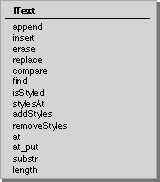
The primary interfaces you need to create and manipulate Unicode text strings, whether styled or unstyled, are provided by IText. It gives you access to the storage mechanism and provides a complete set of protocols for accessing and manipulating both the character and the style data. IText is designed so that you can use it to store unstyled text without the reduction in performance or increase in memory requirements that may be associated with the styling mechanism.
You can create an IText object from another
IText, from an IString, or from an array of char or UniChar.
When you convert between IText and a char-based
format, the data is transcoded. The conversion functions assume
the char-based format is ISO 8859-1.
This figure is a partial listing of the IText interface:
IText also supports the basic_string
interfaces for simple searching and comparison. These functions
perform simple bitwise comparisons, and ignore styling
information. For language-sensitive
comparison of IText strings, use the International Framework's
collation classes.
This figures shows the IText interfaces for searching and comparison:
![]()
Collation Classes
Transcoding Classes
Identifying Text
Boundaries
String Formats
